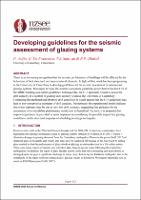| dc.contributor.author | Arifin, Fransiscus | |
| dc.contributor.author | De Francesco, Giovanni | |
| dc.contributor.author | Sullivan, Timothy | |
| dc.contributor.author | Dhakal, Rajesh P. | |
| dc.date.accessioned | 2020-06-18T13:56:07Z | |
| dc.date.available | 2020-06-18T13:56:07Z | |
| dc.date.issued | 2020-04-22 | |
| dc.identifier.uri | https://repo.nzsee.org.nz/xmlui/handle/nzsee/1745 | |
| dc.description.abstract | There is an increasing recognition that the seismic performance of buildings will be affected by the behaviour of both structural and non-structural elements. In light of this, work has been progressing at the University of Canterbury to develop guidelines for the seismic assessment of commercial glazing systems. This paper reviews the seismic assessment guidelines prescribed in Section C10 of the MBIE building assessment guidelines. Subsequently, the C10 approach is used to assess the drift capacity of a number of glazing units recently tested at the University of Canterbury. Comparing the predicted and observed drift capacities, it would appear that the C10 guidelines may lead to non-conservative estimates of drift capacity. Furthermore, the experimental results indicate that water-tightness may be lost at very low drift demands, suggesting that guidance for the assessment of serviceability performance would also be beneficial. As such, it is proposed that improved guidance be provided to assist engineers in considering the possible impact that glazing could have on the structural response of a building in a large earthquake. | |
| dc.language.iso | en | |
| dc.publisher | New Zealand Society for Earthquake Engineering | |
| dc.relation.ispartofseries | 2020;152 | |
| dc.subject | Advances in earthquake engineering research | |
| dc.title | Developing guidelines for the seismic assessment of glazing systems | |
| dc.type | Article | |

